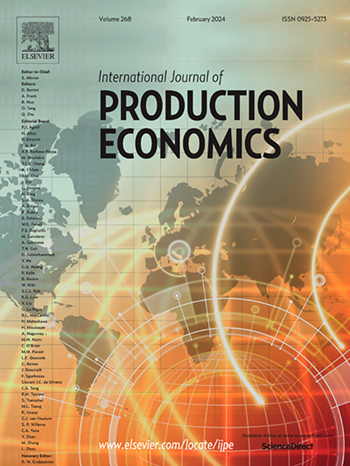产品服务供应链中原始设备制造商的竞争与组织结构共同优化
IF 9.8
1区 工程技术
Q1 ENGINEERING, INDUSTRIAL
引用次数: 0
摘要
智能互联产品(SCP)和数字服务(DS)在促进制造业的数字化和智能化转型方面发挥着举足轻重的作用。在制造业面向服务转型的背景下,SCP 由原始设备制造商(OEM)通过零售商销售,而 DS 则由原始设备制造商直接提供或通过零售商间接提供,从而形成了产品服务供应链。本文构建了一个三阶段动态博弈模型,分析了相互竞争的原始设备制造商通过整合和分离制造部门和 DS 部门所采取的两种 DS 战略,即整合 DS 战略和分离 DS 战略。这些策略包括四种情况:两家原始设备制造商都整合、都分离、一家原始设备制造商整合而另一家分离。我们分析了四种情况下的均衡 DS 水平、SCP 和 DS 的价格、需求和利润,并探讨了均衡状态下供应链成员的服务和定价决策。结果表明,当竞争强度在一定范围内增加时,原始设备制造商可以通过分离制造部门和 DS 部门获得更高的利润率。其次,当两家原始设备制造商采取相同的策略时,如果竞争程度较低,部门整合会带来更高的利润,而当竞争激烈时,部门分离会带来更高的利润。有趣的是,出现了两个纳什均衡:在竞争较弱且数字化研发具有挑战性的非对称情况下,一家原始设备制造商通过采取整合 DS 战略获得最高利润。反之,当竞争激烈且数字化研发相对简单时,两家原始设备制造商可以通过分离部门达到纳什均衡。第三,从零售商和整个供应链的角度来看,在竞争较少的情况下,两家原始设备制造商整合制造服务能带来最高的回报。然而,在竞争激烈的情况下,如果原始设备制造商采取不同的 DS 战略,则能获得最高利润。最后,在没有零售商的激烈竞争市场中,当数字研发投资较低时,非对称方案被证明是最有利可图的,而当数字研发投资较高时,制造与服务分离则会产生最高利润。本文章由计算机程序翻译,如有差异,请以英文原文为准。
Competition and organizational structure co-optimization of OEMs in a product-service supply chain
Smart Connected Products (SCPs) and Digital Services (DSs) play pivotal roles in facilitating the digital and intelligent transformation of the manufacturing industry. In the context of the service-oriented transformation of manufacturing, SCPs are sold by Original Equipment Manufacturers (OEMs) via a retailer, whereas DSs are either provided directly by OEMs or indirectly through the retailer, thereby forming a product-service supply chain. This paper constructs a three-stage dynamic game model and analyzes two DS strategies, i.e., integrated and separated DS strategies, for competing OEMs by integrating and separating manufacturing and DS departments. These strategies encompass four scenarios: both OEMs integrate them, both separate them, and one OEM integrates while the other separates them. We analyze the equilibrium DS levels, the prices of SCPs and DSs, demands, and profits in four scenarios, and explore the service and pricing decisions of supply chain members at equilibrium. The results indicate that OEMs can achieve higher profitability by separating manufacturing and DS departments as competition intensity increases within a certain range. Secondly, when both OEMs adopt the same strategy, integration of departments is more profitable if competition is low, whereas separation yields higher profits when competition is intense. Interestingly, two Nash equilibria emerge: an OEM achieves the highest profit by adopting an integrated DS strategy in an asymmetric scenario when competition is weak and digital R&D is challenging. Conversely, both OEMs can reach a Nash equilibrium by separating their departments when competition is intense and digital R&D is relatively simple. Thirdly, from the perspective of the retailer and the entire supply chain, integrating manufacturing-service at both OEMs provides the highest return when competition is low. However, under intense competition, the highest profits are achieved when OEMs adopt different DS strategies. Finally, in a highly competitive market without a retailer, an asymmetric scenario proves most profitable when digital R&D investment is low, whereas separating manufacturing-service yields the highest profits when digital R&D investment is high.
求助全文
通过发布文献求助,成功后即可免费获取论文全文。
去求助
来源期刊
CiteScore
21.40
自引率
7.50%
发文量
266
审稿时长
52 days
期刊介绍:
The International Journal of Production Economics focuses on the interface between engineering and management. It covers all aspects of manufacturing and process industries, as well as production in general. The journal is interdisciplinary, considering activities throughout the product life cycle and material flow cycle. It aims to disseminate knowledge for improving industrial practice and strengthening the theoretical base for decision making. The journal serves as a forum for exchanging ideas and presenting new developments in theory and application, combining academic standards with practical value for industrial applications.

 求助内容:
求助内容: 应助结果提醒方式:
应助结果提醒方式:


